What we’re thinking
We see a world where we exchange service – helping others make progress – rather than exchanging value; and, actually, where value emerges from progress made.
service – the application of skills and knowledge for one’s, or usually another’s, benefit (helping make progress) Share on XSome service exchanges are direct between two parties; though most appear to be indirect – for example frozen in goods or transitive in nature. Actors need to feel exchanges are equitable (which does not necessarily mean equal)
It is the indirect nature of exchange coupled with certain implementations of service credits – used to mediate temporal and magnitude differences in service exchange as well as lubricate transitive exchanges – that give the impression of value exchange.
Recognising service as the basis of exchange liberates us from an unhealthy fixation on a singular point of (value) exchange. We’re encouraged to find growth before and after that artificial point, avoid a restricting goods vs services debate and harness the circular economy. Moreover, we drive a better definition of value.
Rethinking economic growth: beyond value exchange
You likely feel you experience a world where you constantly exchange things of value. You pay cash for goods that manufacturers, along the supply chain, have embedded value into. And you are receive a salary in exchange for your daily work.
This is something we’ve felt even before Adam Smith told us, in “Wealth of nations” (1776), that goods were the basis of economic growth. That anchored the concept of value in exchange. As well as driving a wedge between goods and services. Casting the later as poor relatives: they are intangible and inconsistent; require customer involvement since delivery and consumption are inseparable; and you cannot create an inventory (building upon Zeithmal, Parasuraman and Berr’s “Problems and Strategies in Service Marketing”)
Multitudes of businesses are built on these premises, as are the curricula of countless business schools, and economics classes at all levels.
It is clearly not an incorrect way to think. GDP per capita in the UK, for example, rocketed from £2,034 in 1776 to £24,402 in 2000 (at constant 2013 British Pounds Sterling). However, it has challenges that I argue are now holding us back. Let’s explore!
Exchanging value
We call today’s prevailing view of how the world works: goods-dominant logic (Vargo & Lush). Visualising the lifecycle of value as in the following diagram.
Consider a car. It starts life as various raw materials within the earth to which we assign some value/worth. A miner extracts these materials and market actors willingly exchange cash or equivalents for the miner’s output. This is higher than the in-ground value. That is to say by the act if extracting the minor has embedded value.
More market actors transform the extracted material into sheet metal, embedding further value. Further actors craft body panels embedding more value. Subsequently, a car manufacturer assembles these panels along with other components, into a car. That car possesses even more embedded value – the value a manufacturer has determined customers desire.
Finally, a manufacturer (or a dealer network) looks to exchange the value embedded in the car for cash with an end customer.
What does the customer do with embedded value they now posses? They destroy, or use, it up; sometimes both. In our car example, some value is destroyed immediately the car is driven of the dealer’s parking lot. The customer uses up most of the remainder as they drive the car around through wear and tear. Time may also destroy some value (changing circumstances, design desires etc)
In our goods-dominant world we try and get services (plural) to fit the same model with service providers embedding value in their service which a consumer exchanges cash for the output of the service.
However, by focussing on a point of exchange, we place four challenges on our growth opportunities.
Challenge 1: misses value before the exchange
Our traditional value-in-exchange model places significant emphasis on the point of exchange, diverting attention from value that can potentially be created before that point.
We’re blinded, as producers, since most marketing sources tell us to prefer consistent products over customisation. In doing so we can streamline production as well as build-up inventories giving us demand flexibility. It’s therefore best to limit customer involvement as that can lead to customisation, hinders centralised production, and removes separation. See the marketing classic on IHIP of Parasuraman and Berr’s “Problems and Strategies in Service Marketing” for more on this.
The prevailing view is that customisation is bad and that producers decide what value customers want (will exchange for).
Seen through the progress economy lens, manufacturers are deciding a compromised progress offered and progress origin they believe all progress seekers are willing to accept (in return for lower progress hurdles, typically equitable service exchange and lack of resource (eg time)).
However, Vargo & Lush’s “The Four Service Marketing Myths“. attempts to dispel the myths behind the marketing 5Is/IHIP. They say (my notes in []):
Vargo & Lush (2004) “The Four Service Marketing Myths“ with notes
- Unless tangibility has a marketing advantage; it should be reduced or eliminated if possible [enabling rapid scalability]
- the normative marketing goal should be customization rather than standardization [enabling greater value creation]
- the normative marketing goal should be to maximize customer involvement in value creation [enabling greater value co-creation]
- the normative goal of the enterprise should be to reduce inventory and maximise service flows [value comes from use (making progress) which varies with experience]
Interpreted in the progress economy, progress helpers should help seeker’s move from their individual progress origin to their individual progress sought. That means understanding individual progress origin and sought and customising as required the help given to reach progress sought. We simply do not realise max value by offering less progress.
Challenge 2: overlooks value beyond the exchange
Additionally, our traditional value-in-exchange approach makes us less interested in what happens after the exchange. Far better for us to move onto the next exchange.
This means we miss “value” after the exchange such as helping the end users to recover “value” such as through recycling, repairing, re-using, re-selling etc. In other words we the value-in-exchange model often aligns with the take-make-waste model of the linear economy rather than the circular economy.
Worse, we may make decisions before the exchange that hinder or prevent those post exchange value recovery activities.
challenge 3: inflexibility in business models
Selling products, which is value-in-exchange by another name, is just one business model. But focussing so heavily on it makes it challenging for us to think of other models. How easy can you adopt hiring, sharing, subscription models if you’re set up to make a big sale?
Challenge 4: gives flawed definition of value
Finally, or perhaps firstly?, the conventional value-in-exchange view heavily influences our understanding and definition of value. Primarily we equate value with worth, tying it to monetary worth or equivalence in exchange. That, in turn, steers and reinforces our thinking towards exchanging value.
Take a look at Mirriam-Webster’s definition of value:
https://www.merriam-webster.com/dictionary/value
- noun:
- the monetary worth of something
- a fair return or equivalent in goods, services, or money for something exchanged
- relative worth, utility, or importance
- something (such as a principle or quality) intrinsically valuable or desirable
- verb:
- to consider or rate highly
- to estimate or assign the monetary worth of
- to rate or scale in usefulness, importance, or general worth
All the definitions revolve around the worth of something in exchange. Reinforcing the value-in-exchange model.
These four challenges limit opportunities to find growth. A limit I believe we are beginning to hit in our modern world. We need to evolve to a new model.
An aside on updating models
Updating models is not unfamiliar in science. Just as scientific models undergo updates to better explain and navigate new findings, economic models should adapt to the changing needs of finding growth.
Maybe you remember learning about the atom at school. At first, we learn the atom is an indivisible unit. This is a model that helps us with basic understanding of elements and compounds. But we quickly need an evolved model to help us understand how compounds form. That model is a divisible atom: sharable electrons, creating bonds, orbit a nuclei of protons and neutrons.
As we advance we need to shift to Bohr’s model. That shows us electrons are in different shells and emit/absorb discrete quantums of energy when they move between shells. To better explain quantum aspects, we need a newer model that models locations of electrons not in shells, but as probabilities of where they can be found. Now the world of quantum tunnelling is explainable.
The value-in-exchange model has served us well for hundreds of years. But now, as we hit the innovation problem, we need to evolve. The progress economy, emphasising service as the fundamental basis of exchange, shifts the focus from a traditional value-in-exchange model to one where value emerges through progress.
Service Exchange
To recap, there are four challenges with today’s traditional value-in-exchange model:
- misses “value” before point of exchange
- overlooks “value” after point of exchange
- complicates thinking on non big-sale business models
- uses/reinforces a flawed definition of value
In the progress economy we see value differently (better). Value incrementally emerges as the seeker makes progress. With maximum value created when a seeker reaches their progress sought (the more desired state they wish to reach). Unlike the traditional view, no inherent value exists before a seeker initiates progress; challenging the notion that we can exchange value.
The key to understanding exchange in the progress economy is that:
- every actor is seeking to make progress in all aspects of their lives.
- progress seekers will seek help to make progress when they lack resource to progress themselves (a progress hurdle we call lack of resource).
- progress helpers offer their resources (that carry capabilities including skills and knowledge) for integration in the belief they can help seekers progress
Since every actor is seeking to make progress, a progress helper is also a progress seeker (most often in a different domain). This dynamic sets the stage for what we term an exchange — an exchange of help. Aligning us with the first axiom of Vargo & Lush’s service-dominant logic (our foundation):
Service is the fundamental basis of exchange
#1
In its simplest form, a progress seeker and helper engage in a direct exchange of service. However, this service exchange is often indirect and may not be immediately apparent to our minds accustomed to value exchange.
Before delving into direct and indirect exchanges, let’s clarify the meaning of service, a term influenced by goods-dominant logic thinking.
What is a service?
In the traditional goods-dominant logic, which is how we typically perceive the world, we start with a goods-first perspective and attempt to fit services (plural) into that. Goods are tangible outputs of a manufacturing process with embedded value. They are physical items we can hold and reason about, which Adam Smith, in the 1700s, concluded drive wealth.
From this perspective we attempt to define services. It turns out in a negative way – they are intangible, inconsistent, require customer involvement since delivery and consumption are inseparable, and cannot be inventoried. This perspective is encapsulated in the classic IHIP definition by Zeithaml, Parasuraman, and Berry’s marketing classic “Problems and Strategies in Service Marketing“.
Service-dominant logic, a foundation of the progress economy, turns this perspective around. It defines service (singular) and then sees how goods fit into that. SD-logic see service as:
the application of competences (knowledge and skills) for the benefit of another party
Vargo & Lush (2008) “From Goods to Service(s): Divergences and Convergences of Logics”
Which focuses us on the process rather than output. Additionally, “for the benefit” can be evolved to “helping attempt progress” since progress equals benefit in the progress economy.
However, not all service benefits another party: we can have self-service. So in the progress economy we have a slightly less restrictive definition:
service: the application of competences (knowledge and skills) to help oneself, or more often, another party to attempt progress
Based on Vargo & Lush (2008) “From Goods to Service(s): Divergences and Convergences of Logics”
Who applies those competences (during progress-making resource integration steps) is open in the progress economy. It could exclusively be the progress helper, or the progress seeker, or a combination.
Finally it helps to conceptualise service in Lovelock & Wirtz‘s four processing types categorisation (from ”Services Marketing”):
- people processing –
- possessions processing –
- mental-stimulus processing –
- information processing –
The role of Goods in a service-first world
Goods, in our service-first world, function as a distribution mechanism for service. Again, service-dominant logic informs us:
Goods are distribution mechanisms for service provision
#3
In practice this means that the application of competence is frozen into goods, allowing it to be transported in time and space. Future acts of resource integration unfreeze those competencies.
A band playing music is a service—musicians applying their instrumental/vocal competences to help others make progress (for example, in enjoying themselves). Their performance can be frozen as a digital file by recording it, which can be distributed as a CD (traditional tangible goods) or streamed over the internet (as an intangible digital goods). When a listener presses play on Spotify or their CD player —a resource integration activity—the performance is unfrozen.
Interestingly, in a service-first view there is no goods versus service debate. Just different ways of offering a service. Something we take advantage of in the pogress proposition continuum and progress resource mix.
With this view of service in mind, let’s first explore direct service exchange
Direct exchange
Direct service exchange is a straightforward concept: you help me make some progress, and in return, I help you with some progress you are seeking.
Such a direct exchange relies on individuals having skills and knowledge to swap and them finding each other to engage in this exchange. For example friends helping each other move house, participating in getting rounds of drinks during nights out, or doing favours for others.
Direct exchange might well be rare in our complex world, but let’s not write off service as the basis of exchange. Understanding direct exchange, and the challenges it poses, sets us up well to explore the more common indirect exchanges that occur.
tracking temporal differences
There’s often a temporal gap in a direct exchange. By that I mean I might help you move this weekend, but you might not need my help for months.
To mediate these temporal differences, we introduce the abstract concept of “service credits“. These are promises of future service. When I provide a service to you, you give me a service credit that I can redeem at a later point in time.
These service credits can take various forms, from a mental note among friends to a formal contract, entries on a central or distributed register/ledger, to tokens/IOU notes you carry with you. The formality of service credit implementation is likely to increase with the level of unfamiliarity or trust required between the parties involved.
aligning magnitude differences
Idealistically one unit of service should be represented by one service credit. But, outside of an altruistic society, that breaks down on views of unfairness. Does you cooking me a meal (or rather you applying your culinary skills for my benefit) equate to me helping you move a 5-bedroom house?
To answer that, we need to introduce the concept of equitable service exchange. Where both parties in an exchange agree the progress they could make (progress potential) with the other’s help is sufficient for the effort they will give in helping the other make progress. Noting that equitable is not the same as equality.
It may be the case that we both feel that a meal in exchange for me helping you move is sufficient. It’s clearly not equal; but if we feel it is equitable, great. Or we could agree that 4 meals is equitable, or 2 meals, or some not yet defined future help.
As with temporal differences, we can mediate magnitude differences through service credits. Where different numbers of service credits can be agreed for each service being exchanged. We might, for example agree that my helping you move is equitable to two meals. So you would offer me 2 service credits if my service was performed first.
And here we begin to get a glimpse into price in the progress economy. Price signals a formalisation of the effort a helper puts into providing help; expressed in terms of number of service credits and the number of exchanges they believe is required for equitability.
More on price, and implications for business model innovation, later.
Now we have this basis of direct exchange, let’s look at indirect exchange.
Indirect exchange
Your experience likely tells you that direct exchanges are not that common. Does that mean our concept of service as the basis of exchange is incorrect? No. As service-dominant logic tells us, the service basis of exchange is masked by indirect exchange.
Indirect exchange masks the fundamental basis of exchange
#2
The most obvious indirect exchange is what we’ll call transitive indirect exchange. I help you and receive a service credit. Our previous intention was I would redeem that with you at a later date. However, what if there’s another progress helper offering to help me with something else I need to progress with, that you can’t. If they decide to accept your service credit from me (perhaps they want your help) then we have a transitive indirect exchange.
Vargo and colleagues identify in 2010’s “Service-dominant logic a review and assessment” four ways that indirect exchanges mask direct service exchange.
These we will call:
- transitive indirect exchange – money (as an implementation of service credits) as a medium of exchange
- distributable indirect exchange – goods as distribution channels for service
- internal indirect exchange – organisations as resource integrators
- network indirect exchange – networks as linkages for exchange –
Let’s explore them in a little more detail.
Transitive indirect exchange – lubricated by service credits
Let’s say I help you progress and in return you give me a service credit. The original intent of that, in direct exchange, is that I will use that credit at a later date to call on your help.
Now, maybe there’s another progress helper that is willing to accept that service credit as a call on their help instead of me helping them progress. So I can get help from them by using the credit I received from helping you.
This is a transitive indirect service exchange; lubricated by service tokens.
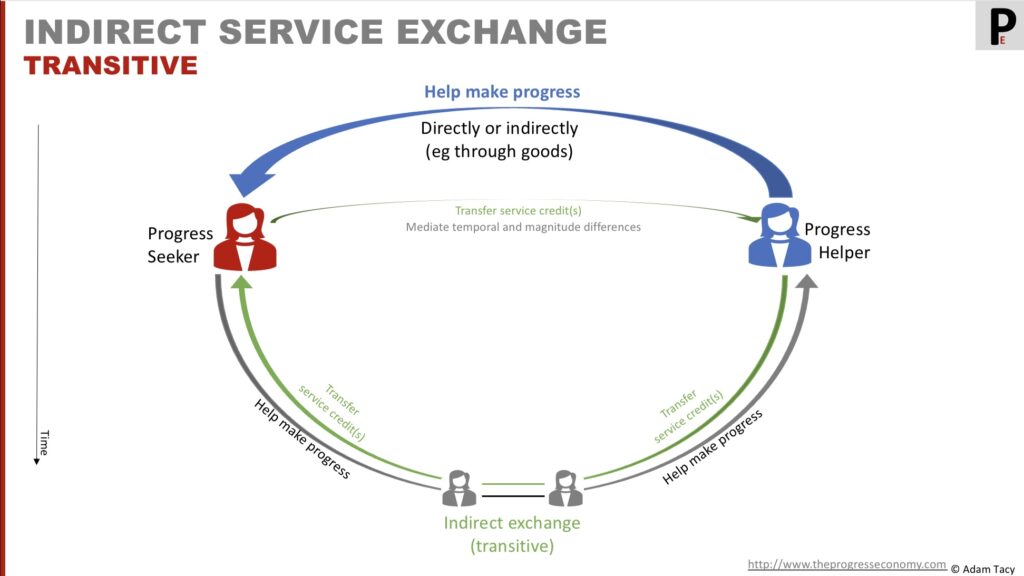
In reality, we would also need to mediate magnitude differences between service involved through service credits.
It doesn’t require all three parties to pre-agree what level of effort is involved with a unit of service credit; but the equitability service exchange progress hurdle brings that alignment.
That gives us another insight into price. Service credits now represent effort a seeker has to put into helping someone else to get the credits required for a service they want.
[A question to, perhaps, resolve later is if transitive indirect exchange is eventually circular]
Distributive indirect exchange – the curious case of goods
The use of goods also mask that service is the fundamental basis of exchange. We’ve already noted above that our current goods-dominant logic puts outputs first. Which implies those outputs (products: goods and services) have value embedded within them. So we exchange that embedded value for other items that have value, typically cash.
However, in our service-first perspective we see that goods freeze skills and knowledge allowing them to be distributed.
In this perspective, goods freeze skills and knowledge, allowing them to be distributed elsewhere. We still have service as the basis of it is just masked by distributive (often together with transitive) indirect exchange.
For example, pouring a glass of water from a tap/faucet is generally seen as using a service; whereas that bottle of water in the fridge is seen as a product. In the progress economy they are interchangeable resources.
Internal indirect exchange
The third example of indirect masking is found in organisations. Organisations integrate and combine micro-specialisations into a progress helper. By that I mean various departments, assembly line workers, layers of management, etc. When we look, there are often limited, or no, direct service exchanges between these micro-specialisms.
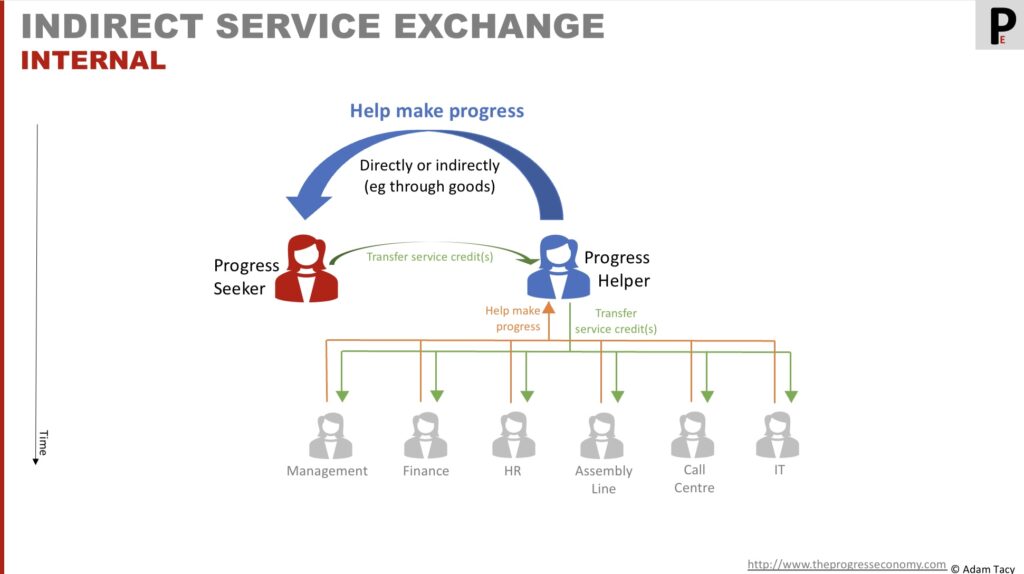
However, when we zoom out we can see a special case of transitive indirect service exchange at play, which we call internal direct exchange.
Each employee/department is applying their skills and knowledge to help the organisation help the progress seeker. Most likely the seeker is giving servce credits to the organisation, which then distributes those across departments/ emloyees.
network indirect exchange
A similar situation to internal indirect service exchange happens in ecosystems – where a group of progress helpers co-ordinate to help a progress seeker. Sometimes behind a progress seeker acting as a façade; sometimes linked from a progress seeker but direct with the seeker (for example external party credit card payment on e-commerce sites).
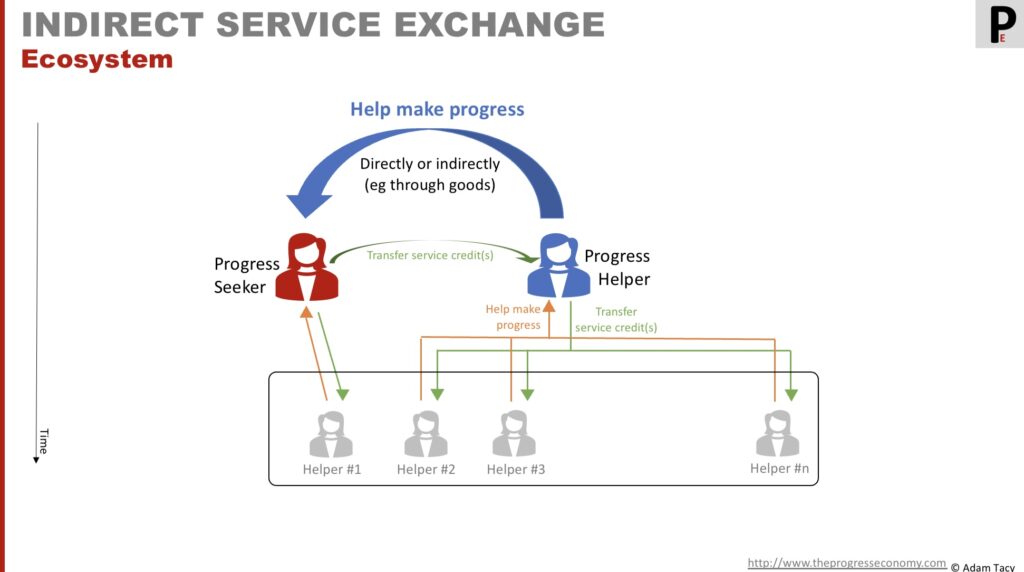
Addressing the four challenges
- misses “value” before point of exchange
- focussing on progress sought drives consultative approach => customisation to max value co-creation
- doesn’t require everything to be fully customisable – progress offered can be segmented; often to address high either high equitable service progress hurdle or for where bulk of seekers are not looking for customisation (progress sought is homogeneous)
- overlooks “value” after point of exchange
- focussing on progress sought extends beyond point of sale
- should bring in circular economy thinking
- interesting if seekers are generally not interested in circular aspects…
- complicates thinking on non big-sale business models
- Price reframed as effort leads to better thinking on how to lower equitable exchange progress hurdle – business model innovation (hiring rather than buying; PaaS; sharing economy; subsidised service (ads, elsewhere etc) and so on)
- uses/reinforces a flawed definition of value
- better definition given, foundation to the above
Key considerations
Viewing the world as one where the basis of exchange is service (helping make progress) is beneficial to growth as it encourages us to:
- look at how we can help make progress (and therefore what progress for a seeker means) rather than focus on outputs
- see that value emerges from making progress rather than being embedded
- remove an obsession over an artificial point of exchange
- opportunities before that point become more visible
- opportunities after that point become more visible
- harness the circular economy
- lose the restricting view that goods and services are competing entities
- and that services are poor in comparison to goods
Temporal and magnitude differences between service swapped are mediated by value-less service credits. And those same credits lubricate transitive indirect service exchange – I help you, you give me service credit(s), I use those to get progress helper’s help.
Which leads us into insights on price in the progress economy that is interpreted by progress seekers as effort in service they need to provide elsewhere in order to obtain (service credits to obtain) a service they are after.
In fact, indirect service exchange masks service as the basis of exchange just as service-dominant logic tells us. We find transitive, distributive (service frozen in goods), internal and ecosystem indirect exchanges.
Finally, we believe we see a world of value exchange due to the particular implementation of service credits we call money and its use in indirect exchange. But that is a restrictive world when looking for growth, innovation and the circular economy. It’s time we dug deeper into the true underlying service basis of exchange.

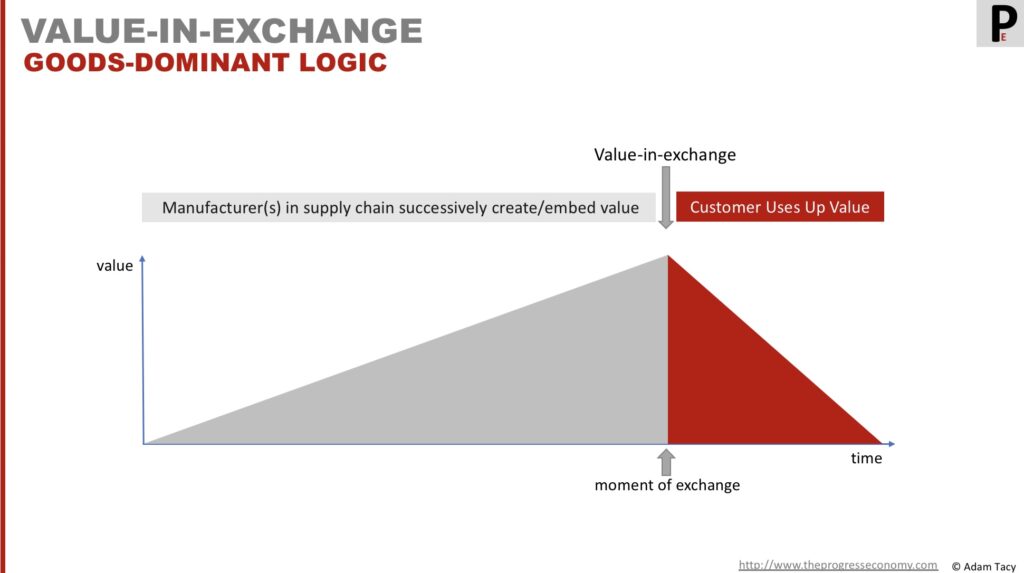
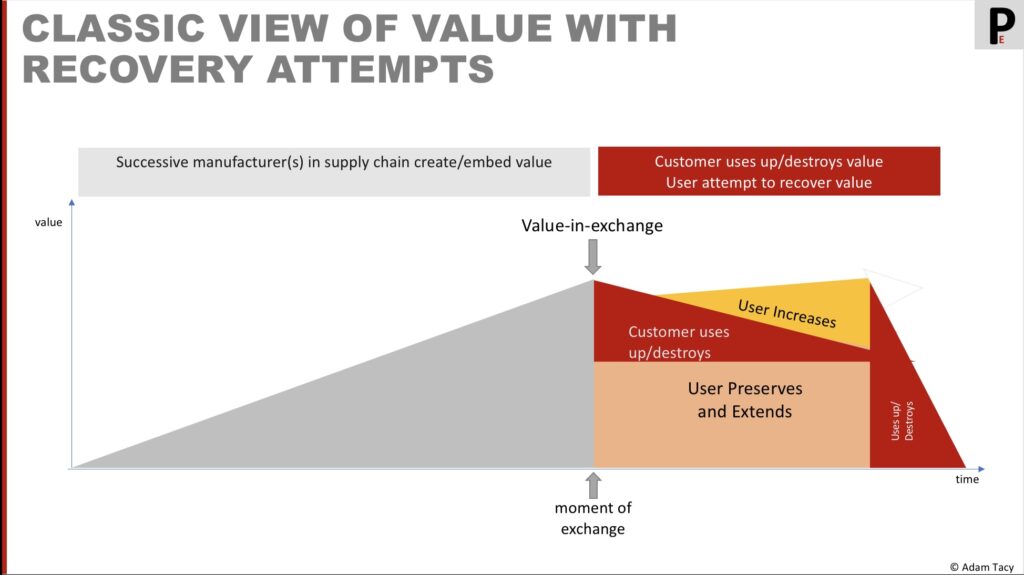


Let’s progress together through discussion…